
Ruidoso is a village in Lincoln County, New Mexico, United States, adjacent to the Lincoln National Forest. The population was 8,029 at the 2010 census. The city of Ruidoso Downs and the unincorporated area of Alto are suburbs of Ruidoso, and contribute to the Ruidoso Micropolitan Statistical Area's population of 21,223.

Bale Grist Mill State Historic Park is a California state park located in Napa County between St. Helena and Calistoga. The park is the site of a water-powered grist mill that was built in 1846 is one of only two water-driven mills remaining west of the Mississippi River.

Kirby's Mill is a historic grist mill in Medford, Burlington County, New Jersey, United States. Originally known as Haines Mill, it was built in 1778 by Isaac Haines and partners along the Southwest Branch of Rancocas Creek. It was the last commercial operating mill in New Jersey.
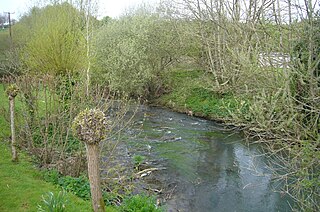
The Bybrook, also known as the By Brook, is a small river in England. It is a tributary of the Bristol Avon and is some 12 miles (19 km) long. Its sources are the Burton Brook and the Broadmead Brook, which rise in South Gloucestershire at Tormarton and Cold Ashton respectively, and join just north of Castle Combe in Wiltshire. The river has a mean flow rate of 57.25 cubic feet per second (1.621 m3/s) as recorded at Middlehill near Box. A variety of flora and fauna is supported by the river including the endangered white-clawed crayfish. Twenty watermill sites have been identified on the river but none now remain in use.
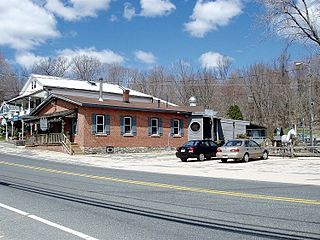
The South Coventry Historic District is a historic district encompassing the historic village center of South Coventry in the town of Coventry, Connecticut. The village, settled in the early 18th century, has served as Coventry's civic center, and also served as an economic center, with textile mills operating in the 19th century. The district was listed on the National Register of Historic Places in 1991.
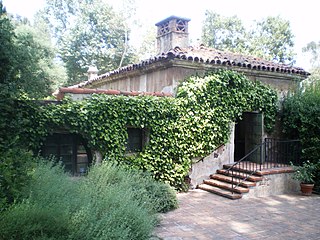
El Molino Viejo, also known as The Old Mill, is a former grist mill in the San Rafael Hills of present-day San Marino, California, United States, and was built in 1816 by Father José María de Zalvidea from the Mission San Gabriel Arcángel. It is the oldest commercial building in Southern California, and was one of the first ten sites in Los Angeles County to be listed on the National Register of Historic Places, receiving the recognition in 1971. The Old Mill has also been designated as a California Historical Landmark.

George Washington's Gristmill was part of the original Mount Vernon plantation, constructed during the lifetime of the United States' first president. The original structure was destroyed about 1850. The Commonwealth of Virginia and the Mount Vernon Ladies’ Association have reconstructed the gristmill and the adjacent distillery. The reconstructed buildings are located at their original site three miles (4.8 km) west of the Mount Vernon mansion near Woodlawn Plantation in the Mont Vernon area of Fairfax County. Because the reconstructed buildings embody the distinctive characteristics of late eighteenth century methods of production and are of importance to the history of Virginia, the site is listed on the National Register of Historic Places despite the fact that the buildings are not original.

The Newlin Mill Complex, also referred to as The Newlin Grist Mill, is a water-powered gristmill on the west branch of Chester Creek near Concordville, Pennsylvania built in 1704 by Nathaniel and Mary Newlin and operated commercially until 1941. During its three centuries of operation, the mill has been known as the Lower Mill, the Markham Mill, the Seventeen-O-Four Mill and the Concord Flour Mill. In 1958 the mill property was bought by E. Mortimer Newlin, restored and given to the Nicholas Newlin Foundation to use as a historical park. Water power is still used to grind corn meal which is sold on site. The park includes five historical buildings, which were added to the National Register of Historic Places in 1983, and 150 acres (61 ha) of natural woodland.

The Water MillMuseum is a historic water mill and local history museum located at 41 Old Mill Road, Water Mill in Suffolk County, New York, USA. It is a 2-story, heavy wood-frame structure with a wood-shingle exterior and composed of two building sections. There is a 2-story, square-shaped main section and 1-story, one-bay wing. Attached to the rear is a 2+1⁄2-story tower and 1-story glassed-in porch. The mill structure dates to the mid-17th century. It operated as a mill until the early 20th century. It is now a local museum.

Abbott's Mill is a historic site that includes an old grist mill in Sussex County, Delaware, 3 miles (4.8 km) southwest of Milford.

Mill City Museum is located in the ruins of the Washburn "A" Mill next to Mill Ruins Park on the banks of the Mississippi River in Minneapolis. The museum, an entity of the Minnesota Historical Society that opened in 2003, focuses on the founding and growth of Minneapolis, especially flour milling and the other industries that used hydropower from Saint Anthony Falls. The mill complex that the museum is within, dates from the 1870s and is listed on the National Register of Historic Places. It is also part of the St. Anthony Falls Historic District and within the Mississippi National River and Recreation Area.
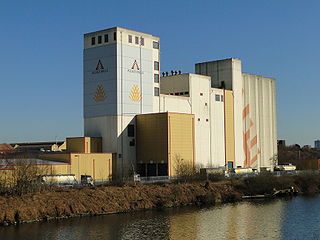
A gristmill grinds cereal grain into flour and middlings. The term can refer to either the grinding mechanism or the building that holds it. Grist is grain that has been separated from its chaff in preparation for grinding.
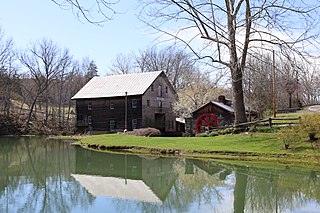
Cook's Mill, also known as The Old Mill and The Greenville Mill, is a historic grist mill and sawmill and national historic district located near Greenville, Monroe County, West Virginia, United States. The district includes one contributing buildings and two contributing structures. The main mill building was built in 1857 on the original stone foundation and site of an earlier mill built in approximately 1796. It is a 2+1⁄2-story, plus basement, hand-hewn post-and-beam building, with massive timbers pegged at their mortise and tenon joints. The district also includes the dam, mill pond, tail race and stream.

The Jervis Gordon Grist Mill Historic District, also known as the Milford Grist Mill and Rowe's Mill, is an historic grist mill and national historic district that are located in Milford, Pike County, Pennsylvania.

Benson Grist Mill is a restoration-replica museum located in Tooele County, Utah in the western United States, which allows visitors to see the inner workings of a latter-nineteenth-century pioneer gristmill. It has four other historic (nineteenth-century) buildings which have been moved onto the site, as well as four ancillary structures, including an open-air pavilion. It covers 6.98 acres along State Highway 138, 0.8 mile southwest of the intersection of the Road with State Highway 36. The museum is owned and operated by a division of Tooele County.

Big Otter Mill, also known as Forbes Mill, is a historic grist mill located near Bedford, Bedford County, Virginia, USA. It was built about 1920 and is a large, 2½-story, mortise-and-tenon framed mill building, topped by an unusual and picturesque mansard roof. The mill retains a nearly complete set of early-20th century machinery, including a 13-feet diameter water wheel, which was used until the late 1940s. Also on the property are a contributing mill race and the foundation of a store. The building is under restoration as a mill museum.

The Jaffrey Mills is a historic mill complex at 41 Main Street, in the central business district of Jaffrey, New Hampshire. It consists of a connected series of primarily brick buildings flanking the Contoocook River just north of Main Street. Its oldest buildings, the original mill and office building, are on the west side of the river. They were built in 1868, and feature mansard roofs and banded dentil brick cornices. The mill building has a tower that originally sported a cupola, but this was removed early in the 20th century. In 1872 the building on the east side was built, and the two sides joined by timber-frame bridges were added in 1897, at the same time the east building was extended northward. Later additions to the north of the east building include a storage area and a loading dock. The mill complex, the only 19th-century industrial complex of its type to be built in Jaffrey, was listed on the National Register of Historic Places in 1982. It has been converted into residences.

Dellinger Mill is a historic grist mill located near Hawk, Mitchell County, North Carolina. It was built about 1901–1903, and is a small unpainted rectangular frame building. It measures 18 feet by 14 feet, 6 inches, and is sheathed in chestnut boards and weatherboard. It has a 23 feet in diameter water wheel that was rebuilt in the 1940s. Other contributing resources are an apple house and the mill site. The mill operated until 1955 and was restored after 1997. It is the last water powered/stone ground grist mill of its kind left in the state of North Carolina.
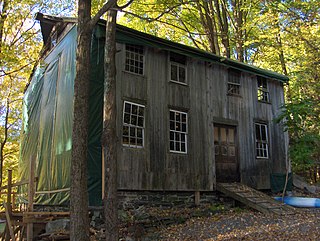
Gillette's Grist Mill is a historic grist mill on Maple Hollow Road in New Hartford, Connecticut. Probably built in the mid-19th century, it is an extremely rare example of a grist mill with a surviving water wheel. The mill property was added to the National Register of Historic Places in 1977.






















